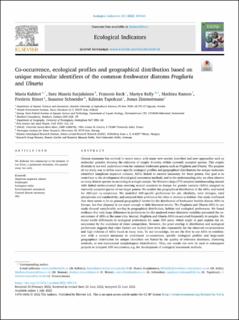| dc.description.abstract | Diatom taxonomy has evolved in recent years, with many new species described and new approaches such as molecular genetics showing the existence of cryptic diversity within currently accepted species. This cryptic diversity is not well understood even for common freshwater genera such as Fragilaria and Ulnaria. The purpose of our study was to define taxon-specific ecological profiles and geographical distributions for unique molecular identifiers (amplicon sequence variants, ASVs) linked to curated taxonomy for these genera. Our goal is to contribute to the development of ecological assessment methods, and to the understanding why we often observe so many diatom species co-occurring in a single sample. We filtered a large (770 samples) metabarcoding dataset with linked environmental data covering several countries in Europe for genetic variants (ASVs) assigned to currently accepted species of our target genera. We studied the geographical distribution of the ASVs, and tested for ASV-pair co-occurrence. We modelled ASV-specific preferences for pH, alkalinity, total nitrogen, total phosphorus and conductivity, and analysed their preference for lakes or streams as habitat. Our study confirmed that there seems to be no general geographical barrier for the distribution of freshwater benthic diatom ASVs in Europe, but that dispersal is not rapid enough to hide historical events. The Fragilaria and Ulnaria ASVs in our study showed considerable overlap in geographical distribution, habitat and ecological preferences. We found evidence that only large differences in preferences for the analysed water chemistry variables prevented the co-occurrence of ASVs at the same sites. Instead, Fragilaria and Ulnaria ASVs co-occurred frequently in samples. We found subtle differences in ecological preferences for some ASV pairs, which might in part explain the co-occurrence by the avoidance of direct competition. However, the great overlap in distribution and ecological preferences suggests that other factors not studied here were also responsible for the observed co-occurrences and high richness of ASVs found at many sites. To our knowledge, we are the first to use ASVs in combination with a curated taxonomy to understand co-occurrence, specific ecological profiles and large-scale geographical distribution for unique identifiers not biased by the quality of reference databases, clustering methods, or non-harmonized morphological identification. Thus, our results can now be used in subsequent projects to interpret ASV occurrences, e.g. for development of ecological assessment methods. | en_US |

